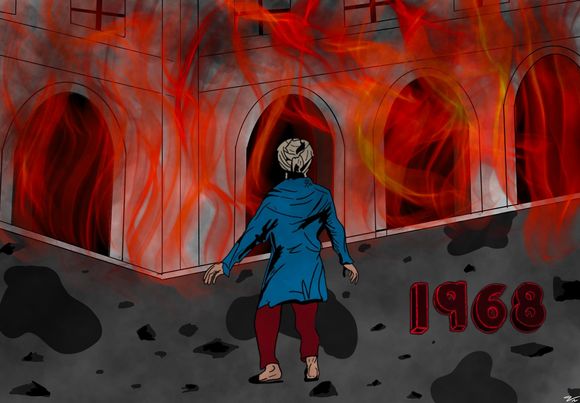
The 1968 Sikh Massacre targeted Sikhs in India leading to 3,000 deaths. Illustration by Vyvyan Nguyen.
By Ansharah Asif
1984 remains one of the darkest years in modern Indian history. 2021 marks 36 years since ‘Operation Blue Star’. The operation was approved by Indira Gandhi, the Prime Minister of India in 19, who ordered an attack on the Sikh Darbar Sahib, also known as the Golden Temple, in June 1984 in Amritsar, Punjab.
The conflict first began on Oct. 31,1984, when Indira Gandhi, the the prime minister of India, was assassinated by her two Sikh bodyguards. Her assassination served as the catalyst for genocidal attacks around India especially in its capital, New Delhi. Sikh victims were dragged out of their cars and homes and beaten to death, fires were set to their house of worship known as Gurdwaras, women were raped and homes and stores were burned down to ash.
Law enforcement did not put an end to this vicious cycle and instead, participated by enacting more violence on behalf of Indira Gandhi by providing mobs with weapons and zero reparations for their actions.
There were 3,000 deaths in a span of three days.
So what has happened to the Sikhs who survived?
They still store the haunting memories and bitter feelings as they wait for justice. Many of the attackers have yet to be charged while the government has offered accountability in silence only.
“I learned about the Sikh Genocide from my family. Since this is a topic that is deeply rooted in every Sikh family,” publicist for Dear Asian Youth and junior Taniya Khattra said. “My family, every November, goes to the Gurdwara to pray for those who lost their lives that night.” .
According to a report belatedly commissioned by the Government of India in 2000, the support of powerful government officials and other influential members of the community, the genocide of the Sikh community could not have taken place.
The 21 million Sikh population of India still feel alienated as India has yet to offer the victims and their families justice. India hopes to uphold its image as a country welcome to all and a government who works to protect their people and has yet to take accountability.
“We can not overlook the brutality towards the Sikh people as even today, many Sikh suffer from what happened to their families and their neighborhoods and streets full of ash they once used to callt their homes,” senior Emroz Sandhu said. “Even today, the protest of Sikh farmers is being completely ignored which goes to show how India has not learned its lesson and still plans to make no amends.”
Today, many Sikhs live in poverty as this crime against humanity has made it challenging for them to build their lives back to what it once was.
“I hope people remember that injustice anywhere is a threat to justice everywhere, so please don’t take this matter lightly just because it directly does not relate to you. Help spread awareness,” Khattra said.
Correction 3/30/22: An earlier version of this story included the incorrect name and occupation of India’s Prime Minister. We are working on correcting the image so it contains the correct year of the massacre, 1984.





